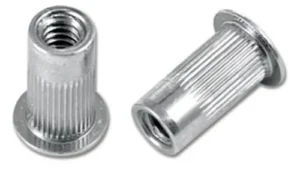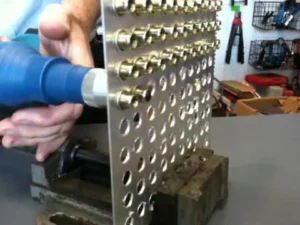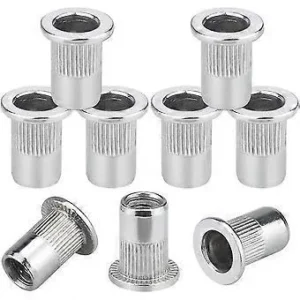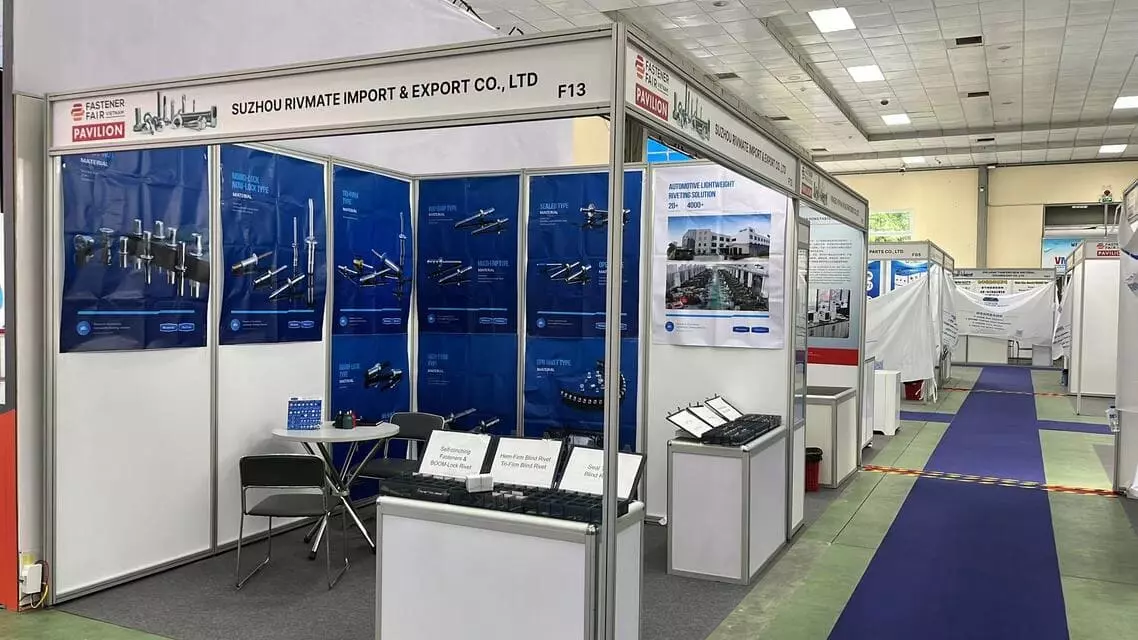How Many Pounds Can a Rivnut Hold?
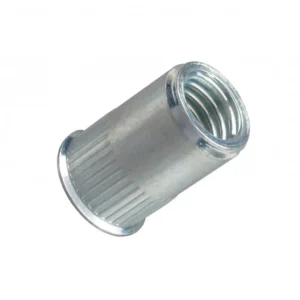
Leading Rivet Nut Manufacturer and Supplier in China

Rivnuts, also known as rivet nuts or threaded inserts, are widely used in industries ranging from automotive to aerospace for their ease of installation and strong, reliable fastening in thin or hard-to-reach materials. But just how much weight can a Rivnut handle? The answer depends on several key factors—including size, material, and installation quality. In this guide, we’ll talk about “how many pounds can a rivnut hold“, break down the typical tensile and shear strength values of Rivnuts made from steel, stainless steel, and aluminum, helping you make informed decisions for your load-bearing applications.
Table of Contents

Definition: Tensile strength refers to the maximum axial load a Rivnut can withstand when force is applied perpendicular to the installation surface—along the axis of the screw. This metric primarily indicates whether the Rivnut can resist being “pulled out” of the base material.
When a screw pulls outward from within the Rivnut, the Rivnut resists this force through the bulge or expanded section formed on the backside of the base material. If the pulling force exceeds its tensile strength, the Rivnut may be pulled out, fracture, or cause tearing in the surrounding base material.
Tensile strength is closely related to the Rivnut’s material, design type (e.g., hex or knurled), installation quality, and the support strength of the base material.
In real-world applications, this is a critical parameter when evaluating Rivnuts for suspended, hanging, or tension-loaded connections.
2. Shear Strength
Definition: Shear strength refers to the maximum load a Rivnut can withstand when subjected to forces parallel to the installation surface. In other words, it measures the Rivnut’s ability to resist “sliding” or “tearing” forces.
Shear forces typically arise from lateral movement between connected parts, side loads, or ongoing vibration. If the shear load exceeds the Rivnut’s capacity, the Rivnut may shear off inside the hole, fall out, or cause damage to the base material.
Shear strength is generally lower than tensile strength.
This metric is especially critical in environments such as heavy machinery or automotive applications where vibration and lateral forces are common.
3. Thread Strength
Definition: Thread strength refers to the maximum load that the internal threads of a Rivnut can support when subjected to tightening, pulling, or compressive forces—reflecting its resistance to thread stripping.
This capability depends directly on thread size, pitch, engagement length, and material strength. If thread strength is inadequate, the joint may fail under load due to stripped threads, disengagement, or screw loosening.
For example, aluminum Rivnuts have softer threads and may strip more easily under high stress.
Stainless steel or carbon steel Rivnuts typically offer greater thread strength.
Thread strength must also be matched with the grade and strength of the mating screw.
4. Material Failure Load
Definition: Material failure load is the maximum force that any part of the Rivnut fastening system (including the Rivnut itself, the base material, or the joint area) can withstand before experiencing permanent damage. It reflects the overall safety limit of the assembly.
This metric concerns the structural integrity of the entire joint, not just the Rivnut. For instance, a strong Rivnut installed in a thin or low-strength base material may still fail at the material interface rather than the fastener itself.
Failures may include tearing of the base material around the hole, local deformation, or crack propagation.
It represents the ultimate load-bearing capacity of the assembly.
This value is typically determined through physical testing rather than theoretical calculation.
What Factors Affect the Load Capacity of a Rivnut?
1. Rivnut Body Material
The material of the rivnut body is one of the core factors determining its load capacity. Different materials have varying mechanical properties, which directly affect the strength and deformation behavior of the rivnut under load, thereby influencing its tensile strength, shear strength, and overall connection stability.
Common Material Types and Their Performance Differences:
Aluminum is lightweight and easy to machine but has relatively low strength, resulting in weaker tensile and shear capabilities.
The yield strength and tensile strength of aluminum are much lower than those of steel, so aluminum rivnuts are prone to plastic deformation or breakage under high loads.
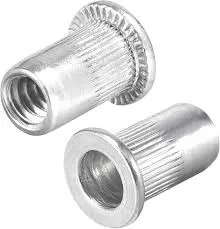
Aluminum rivnuts are suitable for light-load applications or situations with strict weight requirements, such as electronic device housings or lightweight structures.
Carbon steel offers higher strength and hardness, with tensile and shear strengths significantly superior to aluminum. Steel rivnuts can be further strengthened by heat treatment, making them suitable for medium to high-load applications such as industrial machinery and automotive parts. Steel’s high elastic modulus and strong elastic recovery ensure structural stability after installation.
Stainless steel rivnuts have strength comparable or superior to carbon steel and provide excellent corrosion resistance.
The yield strength of 304 and 316 stainless steel is approximately 215MPa and 240MPa, respectively.
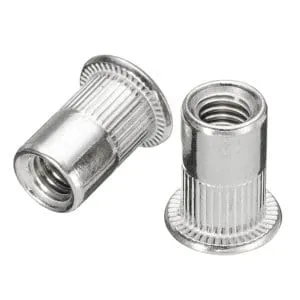
Their corrosion resistance makes them ideal for outdoor, marine, or chemical environments. The combination of high strength and excellent corrosion resistance enables stainless steel rivnuts to withstand heavy loads while maintaining long-term performance stability.
Principles Behind Load Capacity Differences:
a. Yield Strength and Tensile Strength
The material’s yield strength determines the critical point at which permanent deformation occurs under tensile load. Higher yield strength means the rivnut is less likely to deform under stress and can bear higher loads.
b. Hardness and Wear Resistance
Materials with higher hardness reduce wear and damage to threads and expansion zones, maintaining fastening effectiveness, especially under repeated assembly or vibration conditions.
c. Elastic Modulus
The elastic modulus reflects the material’s stiffness under load. A higher modulus means less deformation of the rivnut structure under load, resulting in a more stable connection.
2. Size Specifications

The size specifications of a rivnut are important parameters influencing its load capacity. Size affects thread diameter, wall thickness, contact area with the base material, and overall mechanical strength.
Common specifications and their effects:
a. Thread Diameter
The thread diameter is a key factor determining the rivnut’s effective load-bearing area. Common metric sizes include M4 (4mm), M6 (6mm), M8 (8mm), and imperial sizes like 1/4-20 (~6.35mm), 3/8-16 (~9.5mm), etc.
Larger thread diameters increase the effective thread load area, allowing distribution of greater tensile and shear forces and reducing stress concentration per unit area. This enhances overall load capacity, stability, and durability—especially under vibration or dynamic loading.
b. Wall Thickness and Structural Strength
Wall thickness increases with size, improving rivnut rigidity and its ability to resist deformation. Thick-walled rivnuts distribute stresses more effectively under tensile or shear forces, avoiding local deformation or cracking. Thin-walled rivnuts may deform plastically under high loads, causing looseness or failure. Combining high-strength materials with appropriate wall thickness greatly improves mechanical performance and long-term stability.
c. Contact Area and Load Distribution
Larger rivnuts have greater contact area with the base material’s hole wall. The expanded portion after installation covers a wider area, increasing friction and mechanical locking between fastener and substrate, preventing loosening and rotation.
d. Thread Load Capacity
Larger thread sizes have wider thread profiles and deeper pitches, which provide stronger resistance to tensile forces and reduce the risk of thread stripping or pull-out failure. Deeper threads also increase contact area with bolts or screws, improving overall thread strength and ensuring safe, reliable connections under high stress.
3. Base Material Type and Thickness
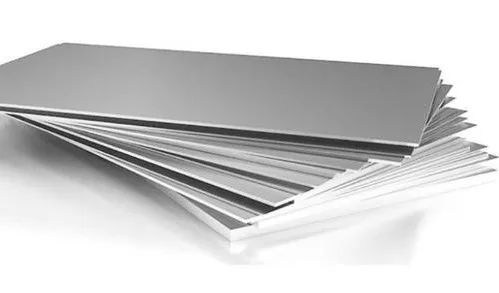
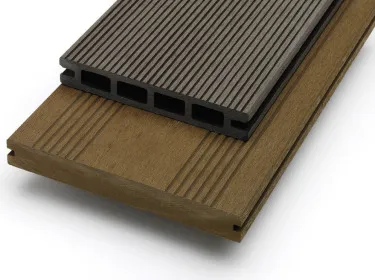
Base Material Strength Affects Rivnut Clamping and Load Capacity
When rivnuts are installed in high-strength substrates (such as structural steel plates or thick aluminum alloy plates), the expanded bulge firmly embeds inside the base material, creating a reliable mechanical lock. Such materials resist local deformation under tensile or shear loads, helping maintain rivnut position and distribute external forces.
In contrast, low-strength substrates (such as plastic sheets, thin aluminum, composites) have poor deformation resistance. Under load, these may warp, crack, or creep, leading to rivnut loosening or failure. These substrates often require special designs (like washers, stiffeners, or reinforced zones) or specific rivnut structures (like large flange or slotted types) to improve connection stability.
Base Material Thickness Must Match the Rivnut’s Recommended Grip Range
Each rivnut model specifies a “grip range”—the suitable base material thickness range for effective installation and clamping force. For example, a grip range of 0.5–3.5mm means the rivnut can properly expand and lock when installed in materials within that thickness.
If the base material is too thin, the expanded bulge may extend beyond the material boundary, causing voids or tearing and losing support.
If the base material is too thick, the expansion may be incomplete, resulting in insufficient clamping force, rivnut rotation, or pull-out.
Therefore, to ensure installation quality and service life, it is generally recommended to select a base material thickness near the middle to upper limit of the grip range to provide adequate deformation space and strong structural support.
Special Considerations for Composite or Stacked Materials
In some industrial applications (electrical housings, automotive panels, aerospace structures), rivnuts may be installed in multi-layered substrates (e.g., metal + insulation + plastic). The total thickness of all layers must be considered, as softer intermediate layers can cause uneven deformation and premature failure in the overall structure.
4. Correct Installation Method
a. Insufficient Expansion
The rivnut works by pulling the mandrel to plastically deform the bottom bulge, forming a clamping structure behind the base material.
Insufficient pulling force, incomplete stroke, or improper tooling during installation can cause the expansion zone to be only partially formed, preventing effective locking inside the hole.
This leads to easy rotation or loosening of the rivnut, eccentric internal threads, structural looseness, and load capacity far below design specifications.
b. Hole Size Too Large or Out of Tolerance
There are strict tolerance requirements between the rivnut outer diameter and installation hole diameter. If the hole is larger than recommended, even if the bulge forms, excessive clearance can cause slipping or rotation.
This is especially true for smooth cylindrical rivnuts (non-hex anti-rotation types), where loose fitting greatly reduces shear strength and anti-rotation performance.
Holes should be drilled with dedicated bits and processed precisely according to manufacturer specifications, using guides or locating fixtures if necessary.
c. Using Improper or Uncalibrated Installation Tools
The quality of rivnut installation heavily depends on the pulling force, stroke accuracy, and loading speed of the tool.
Using manual pliers with insufficient torque, pneumatic guns with low pressure, or unsuitable electric tools may cause incomplete deformation due to inadequate pulling force.
Improper stroke or pressure settings can cause installation defects like misalignment, over-compression, or thread breakage.
It is recommended to use specialized rivet nut installation guns or hydraulic tools, matched with the correct mandrel length and nosepiece size, to ensure consistent installation quality.

5. Structural Design
Different rivnut designs offer varying resistance to rotation and pull-out:
Smooth Round Type: Easy to install but low anti-rotation performance; suitable for non-load-bearing connections.
Knurled or Spined Type: Prevents rotation through friction, ideal for vibration-prone environments.
Hex Body Type: Requires hexagonal hole installation; mechanical locking by shape provides excellent anti-rotation strength, suitable for high-load conditions.
How Many Pounds Can a Rivnut Hold?
Note: Data is based on laboratory testing. Specific values should refer to the manufacturer’s technical datasheet.
Typical Load Capacity of Steel Rivnuts
| Size | Material | Tensile Strength (lbs) | Shear Strength (lbs) |
| M4 / #8-32 | Steel | 500 – 800 | 450 – 700 |
| M5 / 10-24 | Steel | 800 – 1,000 | 700 – 900 |
| M6 / 1/4-20 | Steel | 1,000 – 1,300 | 900 – 1,200 |
| M8 / 5/16-18 | Steel | 1,500 – 1,800 | 1,300 – 1,600 |
| M10 / 3/8-16 | Steel | 2,000 – 2,500 | 1,800 – 2,200 |
| 1/2-13 | Steel | 3,000 – 3,500 | 2,500 – 3,000 |
Note:
- Material has a big impact: Stainless steel is stronger than steel, while aluminum is much weaker; for the same size, material differences can lead to over 30% variation in load capacity.
- Tensile Strength: Maximum limit force before the rivnut is pulled out directly;
- Shear Strength: Maximum limit force before sliding or “shearing off” along the surface;
- Safety Factor: It is recommended to use only 50–70% of the maximum rated load in practical applications to ensure a sufficient safety margin;
- Installation Quality is Critical: Hole diameter, grip thickness, and tool settings significantly affect the final load performance.
Typical Load Capacity of Stainless Steel Rivnuts
| Size | Material | Tensile Strength (lbs) | Shear Strength (lbs) |
| M4 / #8-32 | Stainless Steel | 800 – 1,100 | 700 – 950 |
| M5 / 10-24 | Stainless Steel | 1,100 – 1,400 | 900 – 1,200 |
| M6 / 1/4-20 | Stainless Steel | 1,500 – 1,800 | 1,200 – 1,500 |
| M8 / 5/16-18 | Stainless Steel | 2,200 – 2,700 | 1,800 – 2,300 |
| M10 / 3/8-16 | Stainless Steel | 3,000 – 3,500 | 2,400 – 2,900 |
| 1/2-13 | Stainless Steel | 4,000 – 4,500 | 3,000 – 3,800 |
Note:
- The above data applies to rivnuts made of 304 or 316 stainless steel;
- The difference between shear strength and tensile strength is smaller because stainless steel has higher overall strength;
- Actual load capacity also depends on substrate strength, hole fit, and installation tool accuracy;
- For high vibration and corrosive environments (e.g., marine, automotive chassis), stainless steel rivnuts are recommended.
Typical Load Capacity of Aluminum Rivnuts
| Size | Material | Tensile Strength (lbs) | Shear Strength (lbs) |
| M4 / #8-32 | Aluminum | 400 – 600 | 350 – 500 |
| M5 / 10-24 | Aluminum | 500 – 800 | 450 – 650 |
| M6 / 1/4-20 | Aluminum | 700 – 1,000 | 600 – 850 |
| M8 / 5/16-18 | Aluminum | 1,200 – 1,500 | 1,000 – 1,300 |
| M10 / 3/8-16 | Aluminum | 1,600 – 2,000 | 1,300 – 1,600 |
Note:
- The above data applies to common 6061-T6 or 5052 aluminum alloy rivnuts;
- Tensile strength refers to the maximum vertical load the rivnut can withstand before being pulled out of the substrate;
- Shear strength refers to the maximum load in the horizontal shear direction;
- Aluminum rivnuts are suitable for lightweight material connections (such as plastics or thin aluminum sheets) or weight-sensitive applications (such as aerospace and electronic housings);
- Aluminum rivnuts are not recommended for high-strength or high-vibration applications.
What Are the Safety Guidelines for Using Rivnuts?

In practical applications, the use of rivnuts depends not only on their ultimate performance ratings but also requires full consideration of safety factors, the usage environment, and ongoing maintenance. The key recommendations are as follows:
1. Recommended Load ≠ Ultimate Load
Although manufacturers provide maximum tensile and shear strength data for rivnuts, these are ultimate values obtained under laboratory conditions and should not be used as the basis for actual working loads.
To ensure long-term stability and structural safety, the following principles should be followed:
Recommended Load = Ultimate Load ÷ Safety Factor;
The commonly used industrial safety factor is 2 to 3 times;
For example: If a rivnut model has an ultimate tensile strength of 1000 lbs, the recommended maximum working load should be controlled within 333–500 lbs;
For critical connections such as mechanical load-bearing joints, automotive chassis, and structural supports, a higher safety factor is required.
2. Regularly Inspect Fastening Condition
Over long-term use, connections may loosen due to vibration, thermal expansion and contraction, or material fatigue:
It is recommended to perform regular inspections of the fastening condition (e.g., every 3 to 6 months), especially in high-load or critical locations;
Rivnuts installed on vehicles or vibration-prone equipment should be considered high-risk points and inspected more frequently;
If thread stripping, loosening, or other issues are found, promptly replace the rivnut or upgrade the structural design.
3. Avoid Using Standard Round Rivnuts Under Special Conditions
In scenarios with high-frequency vibration, impact loads, or strong pull-out forces, conventional round rivnuts carry the following risks:
Prone to rotation and slipping due to insufficient friction or improper setting;
Structural fatigue or loosening over long-term impacts.
Recommendations:
Prefer using hexagonal body rivnuts (Hex Body): Mechanical locking with hexagonal holes offers excellent anti-rotation performance;
Or use weld nuts: Welded structures provide stronger connection rigidity;
If rivnuts must be used, select threaded fasteners with anti-rotation features or locking coatings, and use high-strength installation tools to ensure proper setting quality.
Conclusion
Rivnuts are an efficient and reliable blind fastening solution, especially well-suited for applications where access to the backside of the material is not possible. However, in load-critical applications, their performance is highly dependent on the proper match of rivet nut type, material, base material thickness and strength, and installation method.
During the selection phase, it is essential to refer to manufacturer-provided performance data sheets, such as Pull-Out Load and Push-Out Load values, to ensure the chosen product meets the actual load requirements.
For applications involving extreme loads, high-frequency vibrations, or stringent structural safety demands, it is strongly recommended to conduct physical load testing after assembly rather than relying solely on theoretical values, to guarantee fastening strength and operational safety.
Do You Have Any Questions?
Let Us Solve Your Problem
Buy Rivet Nuts from Rivetfix

As a leading fastener manufacturer in China with more than 15 years in the industry, Rivetfix are committed to providing first-class quality fasteners and responsive services to the world. We offers a wide range of rivet nuts and clinch nuts designed to meet the unique demands of your projects. Rivetfix ensures you have the right solution for every application. Choose Rivetfix for versatile, cost-effective, and durable fastening solutions tailored to your specific needs. In addition, we can also provide customized rivet nuts service and clinch nuts according to your requirements.
Contact us now for more information and customization options on Rivet Nuts!
Get High Quality Rivet Nuts Quote!
Send Your Rivet Nut Request
For more than 20 years, Rivetfix has helped customers solve many rivet nuts sourcing needs and technical challenges.
Have a question? Contact us and we’ll provide you with the perfect solution.

